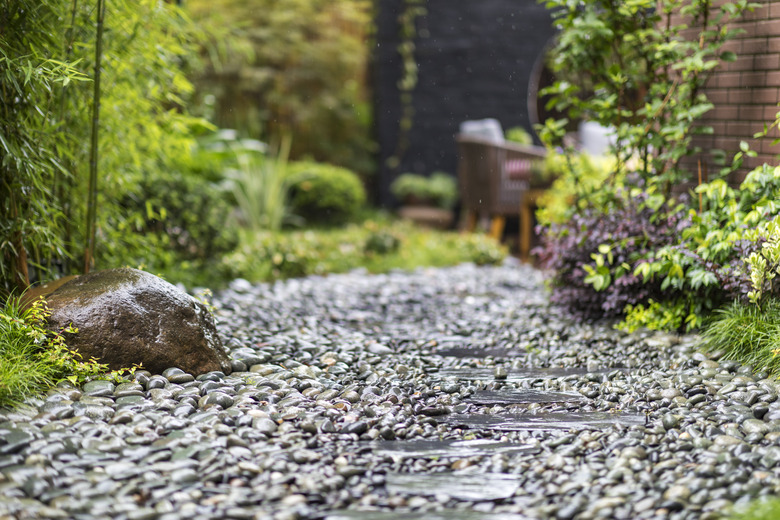How To Landscape With Gravel
When it comes to using rock in landscaping, gravel is definitely one of the more versatile options. It works for small and large paving projects, can replace grass in dry regions and can have a decorative impact in the garden. Even better, it's a more budget-friendly landscaping material than alternatives and lends itself to DIY projects more easily than other types of stone. There's always a spot in any landscape or property that could use a little gravel for decoration and shaping.
Pave a Path
Gravel is an efficient and also easy way for paving material for walkways in a garden or yard. Only a few inches of ground need to be dug out to create room for the gravel, which means you can do the job with a shovel rather than special excavation equipment. In order to ensure the path is solid, lay a compact base of crushed stone pack on it, and wet the stone pack before placing landscaping fabric over it to keep weeds from growing in the path. Some type of edging is necessary to keep the gravel in place, too; plastic, metal, wood and stone can all edge a gravel path. After the edging is installed, pour the gravel onto the path, and rake it into place.
Cover a Patio and Driveway
Gravel also is an effective paving material for larger areas in a landscape. Create a patio with the loose stones for a rustic option. Gravel is suitable for a patio with a curved shape, such as a circle, oval or even a kidney, because gravel can be used to fill in areas bordered by edging. As with a gravel path, though, lay a compact base and landscaping fabric to keep the patio firm and free of weeds.
Gravel can also be used to pave a driveway. The process is more complicated than installing a path or patio because several layers of gravel must be laid to create a firm, stable surface to park vehicles. Typically, the bottom layer should contain crushed rock with a 6-inch diameter while the second layer should have 2- or 3-inch-diameter stones. On top, place traditional pea gravel to finish the driveway.
Fill in a Garden
If you live in a region such as the U.S. Southwest, where conditions make it difficult to maintain a lush, healthy lawn, then gravel is an option for surfacing open areas in a desert garden or yard. It creates visual interest in an otherwise sparse site.
It can also be used as a top-dressing around plants such as the desert marigold (Baileya multiradiata), which is hardy in arid parts of U.S. Department of Agriculture plant hardiness zones 7 through 10, and organ pipe cactus (Stenocereus thurberi, zones 10-11). Alternatively, use a bed of gravel to highlight garden sculptures; pair contrasts, such as dark gravel with light-colored stone statues, to draw the eye.
Create a Border
You don't have to fill an entire garden bed with gravel to add a decorative touch to the landscape. Gravel also works in borders around yard features, providing more visual interest than simple plastic or metal edging allows. Set two pieces of edging in place to create a channel, and fill the channel with gravel.
Gravel can also be used to create borders around flowerbeds, trees and other plants in the landscape or to accent other features such as a fountain or waterfall. If you live in a corner house, lay a gravel border at the corner of the lawn to prevent passersby from cutting across the lawn and damaging grass and other plants.
